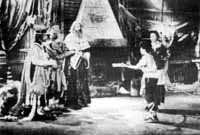
Amahl meets the night visitors.

Christians have always looked to Jesus as a human embodiment of the divine. Understanding and articulating the nature of that embodiment has taxed minds for centuries. The most widely-accepted formulation is the Nicene Creed (325 A.D.), which describes Jesus both as "God of God, Light of Light, Very God of Very God; begotten, not made, being of one substance with the Father" and "made man, and was crucified for us under Pontius Pilate."
This Creed, created by and for the church, stands independent of my opinion of it. Yet, knowing the history of its composition, I generally find the words stultifying rather than evocative. What does draw me into deeper identification with the person and passion of Jesus is the imaginative imagery of poetry.
Recently my imagination was captured by the words of a song from Amahl and the Night Visitors. The three Magi come to the hut of a widow and her crippled son to rest on their way to find "a child the color of wheat, the color of dawn" (and Amahl's mother sings, in counterpoint, that she knows such a child [her own] "the color of wheat, the color of dawn." It was during a memorial service that these words (sung because the deceased had directed the musical at church) latched themselves onto my brain.
Apt images, like sparklers, arouse my imagination and, like fireworks, brilliantly illumine the darkness. Verbal descriptions flatten the experience.
Like a sparkler, for me, "child of wheat" conveys the earth from which wheat arises, the food that nourishes us, the broken bread around which the human and Christian communities form. Also, I find human suffering, anguish and death through the absence of that which nourishes. So, "child of wheat" conveys, in my imagination, the fullness of the human experience and the universe of which we are a part, and of which Jesus is fully a part.
Like a sparkler, "a child the color of dawn" speaks to me of the freshness of each new day, the morning light that follows night's darkness, the hope and rebirth of wonder of the human spirit. The phrase also speaks to me of the resurrections following our many deaths.
What language do we use to think and talk about the deepest realities of our lives: our convictions and our hopes, our beliefs and our actions? At the times of deep heaviness--times when we are against the wall with grief or betrayal or despair or death--how do we articulate the scouring of our spirits and the tenuously fragile tracings of hope that seem almost too good to be true? How do we speak of Jesus as the one who touches the fullness of our human experience and, yet, whose person, actions and words became a channel for our realization of the divine in us and in this world?
Never did I expect a religious revelation at a memorial
service. In the midst of the darkness of the loss of a friend,
I experienced "the color of dawn."
--Robert H. Tucker
28 June 1999